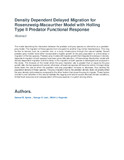Density Dependent Delayed Migration for Rosenzweig-Macaurther Model with Holling Type II Predator Functional Response
Date
2019-10-28Author
Apima, Samuel B.
Lawi, George O.
Kagendo, Nthiiri J.
Metadata
Show full item recordAbstract
The model describing the interaction between the predator and prey species is referred to as a predator-prey model. The migration of these species from one patch to another may not be instantaneous. This may be due to barriers such as a swollen river or a busy infrastructure through the natural habitat. Recent predator-prey models have either incorporated a logistic growth for the prey population or a time delay in migration of the two species. Predator-prey models with logistic growth that integrate time delays in density-dependent migration of both species have been given little attention. A Rosenzweig-MacAurther model with density-dependent migration and time delay in the migration of both species is developed and analyzed in this study. The Analysis of the model when the prey migration rate is greater than or equal to the prey growth rate, the two species will coexist, otherwise, at least one species will become extinct. A longer delay slows down the rate at which the predator and prey population increase or decrease, thus aecting the population density of these species. The prey migration due to the predator density does not greatly affect the prey density and existence compared to the other factors that cause the prey to migrate. These factors include human activities in the natural habitats like logging and natural causes like bad climatic conditions, limited food resources and overpopulation of the prey species in a patch among others.
URI
https://doi.org/10.9734/arjom/2019/v15i330148https://www.journalarjom.com/index.php/ARJOM/article/view/30148
http://r-library.mmust.ac.ke/123456789/1670
Collections
- Gold Collection [1026]

